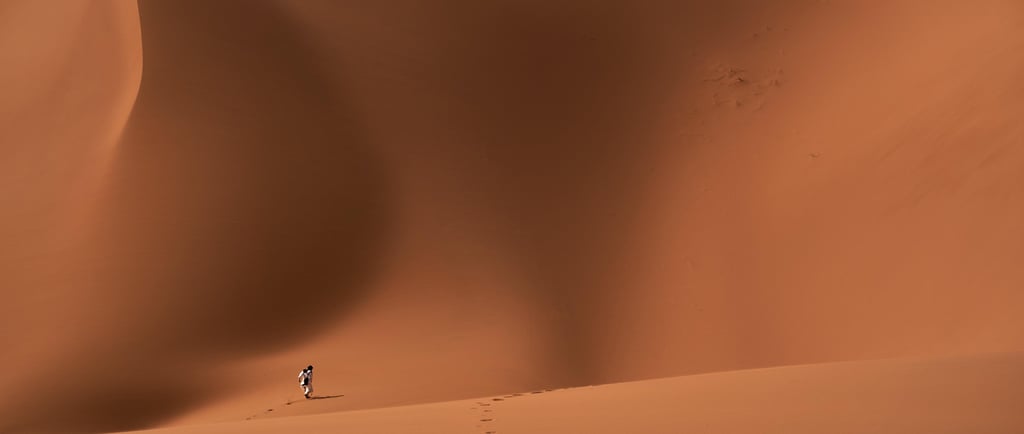Journey West @ www.xinjiang.travel
Taklamakan Desert: Into the Heart of China’s Great Sand Sea
The Taklamakan Desert, known as the "Sea of Death," is one of Earth’s most mysterious and awe-inspiring deserts. Hidden within Xinjiang’s vast basin, it offers a rare glimpse into ancient Silk Road history, untamed natural beauty, and the power of survival in silence.
XINJIANG LANDSCAPES
Daniel Bai
5/12/20252 min read


A Desert of Legends and Lost Cities
The Taklamakan Desert sprawls across over 330,000 square kilometers in the Tarim Basin of southern Xinjiang, making it China’s largest desert and one of the most formidable in the world. Its name may come from the Uighur phrase meaning "you go in, but you won’t come out" — a warning shaped by centuries of myth and peril.
But beyond the fearsome name lies a desert rich with archaeological wonders and ancient Silk Road lore. Ruins of lost kingdoms, like Loulan and Niya, lie buried beneath its dunes — silent witnesses to trade, migration, and the endurance of humanity in the harshest environments.
The Beauty of Isolation
Unlike the more tourist-friendly deserts of North Africa or the Middle East, the Taklamakan remains wild, remote, and hauntingly beautiful. With its golden dunes stretching endlessly beneath a cloudless sky, it offers a dramatic and meditative landscape.
Vast and ever-changing, its dunes can tower over 300 meters tall and move with the winds, constantly reshaping the land. During sunrise or sunset, the sand glows in shades of amber, rose gold, and deep orange, creating a painterly horizon that stirs the soul.
Desert Adventures in the Taklamakan
Cross-desert Highways: The Tarim Desert Highway and the Southern Xinjiang Desert Highway allow travelers to journey straight through the heart of the desert — a rare experience unmatched anywhere else on Earth.
Camel Treks: In areas like Hotan or Qiemo, short camel tours are available for travelers to experience the desert as ancient traders once did.
Oasis Culture: Visit edge cities like Kashgar, Hotan, and Kuqa, where life has bloomed for centuries on the desert's fringes.
Photography Expeditions: Capture the surreal beauty of the dunes, abandoned Silk Road ruins, and isolated poplar forests that dot the desert’s edge.
Archaeological Tourism: With permission, explore historical excavation sites and visit museums housing mummies and Silk Road relics unearthed from the sands.
Travel Tips
Best Time to Visit: Autumn (September–November) offers cooler temperatures and clearer skies.
How to Get There: Major entry points include Kashgar, Hotan, Korla, and Luntai, with roads leading into the desert interior.
Weather: Summer temperatures can exceed 45°C (113°F); winters are bitterly cold. Always plan carefully.
Pack Essentials: Sun protection, layered clothing, extra water, dust masks, and wind gear.
Guided Tours: Recommended for deeper desert exploration or archaeological interests.
Culture at the Edge of Survival
Despite its extreme environment, the Taklamakan is surrounded by vibrant Uighur and Kazakh cultures, thriving in the oases and towns that ring the desert. Local music, crafts, bazaars, and traditional homes create an inspiring contrast to the emptiness just beyond.
From Hotan’s jade markets to ancient Buddhist caves near Niya, the region speaks to thousands of years of resilience and adaptation. Sharing nang bread and tea under a grapevine-covered courtyard reminds you: life, even at the desert’s edge, can be rich and welcoming.
Final Thoughts
The Taklamakan is not just a place on the map — it’s a frontier of imagination, history, and raw natural power. Few places on Earth evoke such a deep sense of solitude and wonder.
To stand in the Taklamakan is to feel small in the face of time, but also deeply connected — to traders, travelers, and cultures that once braved its silence. If you're seeking more than just a beautiful view — if you're drawn to mystery, stillness, and the stories hidden beneath the sand — then the Taklamakan awaits.
